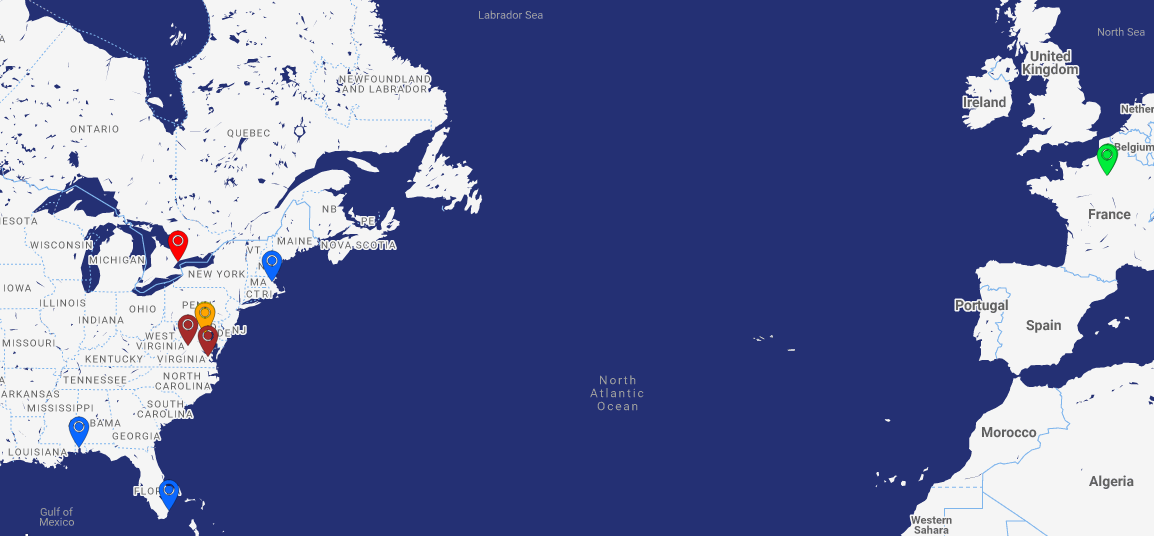SCOTUS Map: November 2018

on Nov 30, 2018 at 12:19 pm

With its newest member seated on the Supreme Court (and officially included in the latest class picture), the justices continued to project a united front, emphasizing their familial bonds and eschewing the labels of “conservative” and “liberal” altogether.
“It was Justice Thomas who tells me that when he first came to the court, another justice approached him and said, ‘I judge you by what you do here. Welcome,’” Justice Sonia Sotomayor recounted in a recent interview with CNN’s David Axelrod. “And I repeated that story to Justice Kavanaugh when I first greeted him here… The nine of us are now a family.” When Axelrod noted that the court will lean conservative for the rest of Sotomayor’s career, Sotomayor immediately replied: “I don’t know what that word means. ‘Conservative,’ ‘liberal,’ those are political terms. Do I suspect that I might be dissenting a bit more? Possibly.” The full segment is available here.
Despite their assertions of nonpartisanship, the justices were repeatedly questioned on the court’s dynamic going forward — in multiple instances, by bemused students and journalists outside of the United States. In a November 12 conversation at the University of Toronto, the first question that Supreme Court of Canada Justice Rosalie Silberman Abella asked Justice Elena Kagan was, “Do you like beer?” Laughter rippled through the room, and Kagan smiled before answering, “What was your second question?”
During the student question-and-answer session, the inquiries for Kagan were mostly variations on the same theme. With the presence of Justice Clarence Thomas and now Justice Brett Kavanaugh on the bench, how can the Supreme Court be considered legitimate in its treatment of women who have experienced violence? I care about the institution and my colleagues a lot, Kagan responded, so “that’s something that I’m not going to be talking about.” Should the Supreme Court be a “force for good” in divided times? Our job is to decide legal questions and not to bring together a fractured American public, Kagan asserted, though there are ways of doing that job that do not exacerbate divisions within the country. How do the justices maintain a nonpartisan image when the confirmation process is increasingly politicized? “I feel a little bit as though I’m repeating myself,” Kagan said. “Clearly, this is the question of the day, right?”
Video of the event is available online. The Globe and Mail and The Toronto Star covered the talk.
In France, Justice Stephen Breyer also faced questions about his new colleague. While at the Paris Peace Forum on November 13, he sat for an interview with France 24, which asked whether Kavanaugh’s confirmation means that the majority of the Supreme Court is now conservative. “‘Conservative’ and ‘liberal’ are terms used by the press,” Breyer responded (echoing what Sotomayor had said in her CNN interview). He doesn’t consider himself a “liberal,” Breyer explained. “Sometimes I am, and sometimes not—in a political sense. Those are political words.”
Pressed by the reporter to say whether he and Kavanaugh might disagree on social issues, Breyer answered with a hint of exasperation: “We don’t know. If we were voting as citizens, perhaps. But as judges, we’ll see… If you were in my position, and you had gone to the conference last week and the week before, you would say, we’ll see. He probably doesn’t know himself how he will decide most issues.”
Two days later, Breyer spoke at a Franco-American Fulbright Commission symposium on law as soft power in the relationship between the United States and France. In an interview with RFI, Breyer deflected once again when queried about Kavanaugh’s contentious confirmation process. “These are exactly the types of question that I cannot answer… If people do not like the way it happens, they have the choice: the choice to elect someone else, other senators.” Asked when he might retire, Breyer noted his intention to stay “until I cannot do the job.”
Sotomayor visited Harvard Law School on November 13, where she spoke to students and adjudicated the final round of Harvard Law School’s Ames Moot Court Competition. The Harvard Gazette covered Sotomayor’s afternoon conversation, during which she called Supreme Court confirmation hearings “a bit more of a charade” than in the past. Video of the moot court final is posted on YouTube.
Later that week, Sotomayor traveled to Florida to promote her new children’s book at the Miami Book Fair. C-SPAN has video of the event.
In other November news:
- Justice Samuel Alito delivered a lecture on religious liberty at The Catholic University of America’s Columbus Law School on November 1.
- Sotomayor returned to Mobile, Alabama, for the christening of the USNS Puerto Rico on November 10. Per Navy tradition, she broke a bottle of sparkling wine over the ship’s bow. Coverage comes from AL.com.
- Chief Justice John Roberts presented Michigan’s 15th Judicial District Court Judge Libby Hines with the National Center for State Courts’ 2018 William H. Rehnquist Award on November 15.
- Retired Justice Anthony Kennedy gave the keynote speech at the 2018 International Churchill Conference on November 10, which was covered by the Washington Times. Video of the speech is available on C-SPAN.
- Kennedy expressed confidence in the court during a November 16 event at the University of Virginia School of Law’s Karsh Center for Law and Democracy. “The public will see the system works,” he predicted, according to UVAToday. “We’re the only branch of the government that gives reasons for what we do. It seems to me that the public will very soon see that the court is operating in a collegial, deliberative, thoughtful, inspiring way… Over time, and over a very short time, you will see that the system has worked and these justices are working well with their colleagues.” The Cavalier Daily and The Roanoke Times provide additional coverage. Video is posted on Bloomberg.



